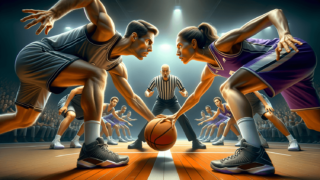
Basketball Coaching Violation Rule: How It’s Called
Written by: Basketball Universe
Last updated:

In the fast-paced, high-flying world of basketball, understanding the rules of the game ensures that fair play prevails on the court. One such rule, the basketball coaching violation, can be a bit of a head-scratcher for newbies and seasoned pros alike. Fear not, hoops aficionados! In this blog post, we’ll unravel the mystery behind this often misunderstood infraction, explain how it’s called, and help you become a true connoisseur of the hardwood. So, lace up your sneakers and let’s dive into the fascinating world of basketball coaching violation rules. Ready, set, swish!
Basketball Coaching Violation Rule: How It’s Called
A basketball coaching violation occurs when a coach or bench personnel displays unsportsmanlike behavior, enters the court without permission, or improperly substitutes a player. Officials call this violation by blowing the whistle, indicating the offender and assessing a technical foul. The opposing team then receives two free throw attempts and possession of the ball. It is essential for coaches to understand and abide by the rules to maintain decorum and ensure the game is played fairly.
Introduction to Coaching Violations in Basketball
Coaching violations are an essential aspect of basketball rules that maintain the sanctity and decorum of the game. These rules focus on the behavior of coaching staff, team representatives, and the legality of on-court actions. Understanding these rules can be crucial for coaches, players, and fans alike, as it helps create a seamless playing environment, fosters sportsmanship, and paves the way for a fair game. If you’re eager to hit the ground running, let’s dive deeper into understanding the basketball coaching violation rule and how it’s called.
Common Coaching Violation Scenarios
Coaching violations encompass a diverse range of scenarios. The onus is on coaches and their staff to be aware of these situations and act responsibly. Let’s explore a few common cases where coaching violations may be called:
Unsportsmanlike Conduct
Foul language, inappropriate gestures, excessive disagreements, or blatantly disrespecting officials or opposing teams fall under unsportsmanlike conduct in basketball. Coaches must maintain their composure and exercise restraint when emotions run high during the game. Unsportsmanlike conduct may lead to a technical foul against the offender.
Unauthorized Court Entry
Coaches must remain off the court and within the confines of the coaching box throughout the game. Entering the court without the officials’ permission, even to offer tactical advice or communicate with players or officials, constitutes a coaching violation. Coaches can, however, address their players during timeouts and interruptions when the ball is dead.
Illegal Substitution
Coaches must substitute players in accordance with basketball rules. Substitution can only occur during a dead ball, and the substitute has to check in at the scorer’s table before entering the game. Failure to follow the substitution protocol may result in a coaching violation and cause the officials to assess a technical foul.
The Calling Process: Decoding the Officials’ Signals
When a coaching violation occurs, the officials play a crucial role in maintaining order and enforcing the rules. Here’s a breakdown of how the calling process works:
Step 1: The Whistle
The first step in calling a coaching violation is the officials’ whistle. A sharp, piercing blow indicates that a violation has occurred, thus bringing the game to a halt. The official blowing the whistle generally has the responsibility for communicating the violation to the rest of the crew and the scorer’s table.
Step 2: Indicating Offender and Violation
Once the game stops and attention has shifted to the official, they will indicate the offender using established hand gestures. These gestures describe the nature of the violation. For example, the official will point at the coach or bench personnel who committed the violation and will use a specific hand signal for unsportsmanlike conduct, unauthorized court entry, or illegal substitution.
Step 3: Penalty Assessment
After indicating the nature of the violation, the official assesses the appropriate penalty. In most cases, a technical foul is assessed against the offender. The opposing team is then awarded two free throw attempts in addition to retaining possession of the ball. Exceptions may apply for minor infractions, such as delay of game, which may warrant a warning before a technical foul is called.
Tips for Coaches to Avoid Violations
Although coaching violations can happen to the best of us, it is always in the best interest of coaches to adhere to the rules of the game. The following tips can help you avoid coaching violations and set a strong example of sportsmanship for your players:
Study the Rulebook
Success in basketball starts with understanding the game inside and out. Spend time studying the basketball rulebook, which encompasses every regulation that governs the game. This knowledge will not only guide you through potential coaching violations but also empower you to advocate for your players should a controversial call arise.
Conduct Yourself Professionally
Lead by example when it comes to maintaining professionalism on and off the court. Show respect and dignity at all times, even amid heated exchanges or challenging circumstances. Remember, your attitude sets the tone for your players and the game itself.
Seek Clarity from Officials
Officials are subject to human error, and there may be instances when coaches disagree with their decisions. Instead of immediately contesting a call, calmly approach the official and seek clarification on their decision. This approach yields better results and helps avoid unnecessary conflicts during the game.
Practice Time Management
Planning an efficient in-game schedule, including substitutions and breaks, minimizes the risk of illegal maneuvers. Timeouts offer the perfect opportunity to provide players with tactical advice or motivation without violating the rules. Thoughtful management of these aspects can significantly reduce the possibility of coaching violations.
Coaching Violations in Different Basketball Leagues
While the basic framework remains the same across leagues, it’s important to understand the nuances of specific regulations in each league you participate in:
NCAA (National Collegiate Athletic Association)
The NCAA comprises three divisions, with each having unique rules governing coaching violations. Although the standards are similar to the professional leagues, there may be additional caveats or restrictions for coaches based on the collegiate framework.
NBA (National Basketball Association)
The NBA’s professional status calls for stringent regulations and penalties surrounding coaching violations. As coaches and players represent the highest level of basketball in the world, adhering to the NBA’s rules is paramount for maintaining the integrity of the sport.
FIBA (International Basketball Federation)
FIBA competitions include international matches, World Cup events, and regional contests. As basketball’s global governing body, FIBA sets the overall framework for basketball rules, including coaching violations. It’s essential to familiarize yourself with FIBA regulations if you are coaching in any international competition.
Be Prepared, Play Fair, Enjoy the Game!
Coaching violations may initially seem overwhelming, but with an in-depth understanding of the rules and how they’re called, coaches can champion the true spirit of the game. By staying informed of the latest basketball rules in your league, managing your bench diligently, and maintaining professionalism at all times, you’ll not only minimize the risk of coaching violations but also create an enjoyable environment for your players, staff, and fans alike. Stay vigilant, nurture sportsmanship, and most importantly, enjoy the fantastic game of basketball!
Understand the Role of the Coaching Box
One crucial aspect of avoiding coaching violations is understanding the role of the coaching box. It is a designated area where coaches and other team officials can stand or sit during the game. The coaching box’s primary purpose is to provide a clear space for coaches to communicate with their players and offer guidance without disrupting the flow of the game. Familiarizing yourself with the dimensions and limitations of the coaching box can help you avoid coaching violations related to unauthorized court entry or interference with gameplay.
Working with Your Support Staff
An often-overlooked aspect of avoiding coaching violations is ensuring that all support staff members, including assistant coaches, trainers, and managers, understand the rules and expectations for behavior. It’s essential to cultivate an atmosphere of discipline and professionalism within your team, which extends beyond the players on the court. Conduct regular training sessions and meetings with your support staff to ensure everyone is on the same page regarding avoiding coaching violations and promoting sportsmanlike behavior during the game.
Being an Effective Communicator
Effective communication is the cornerstone of successful coaching. Coaches must convey their ideas and instructions clearly and concisely to players. Mastering the art of communication can not only help minimize misunderstandings and disputes but also reduce the risk of coaching violations. Work on developing your active listening skills, nonverbal communication, and ability to convey complex ideas succinctly to build trust and understanding with your players and foster a positive team environment.
Know the Triggers: Common Actions that Lead to Coaching Violations
While it’s essential to be proactive in avoiding coaching violations, it’s equally important to recognize the triggering actions and behaviors that lead to violations. Some common triggers include:
- Arguing with or reacting aggressively towards officials or opposing teams
- Failing to provide timely and accurate information regarding substitutes, timeouts, or other on-court changes
- Interfering with play or delaying the game by stepping onto the court at the wrong time
- Allowing frustration or emotions to detract from professional behavior
Awareness of these triggers can help coaches identify potential issues and resolve them proactively, thus minimizing the risk of coaching violations.
Consulting with Peers and Mentors
Another helpful approach to avoid coaching violations is actively seeking advice and guidance from more experienced coaches or mentors. These individuals can offer invaluable insights and strategies for managing emotions, preventing violations, and fostering a culture of professionalism and respect. Consulting with mentors can also pave the way for constructive discussions that help coaches learn from one another and grow in their roles.
In Summary
Mastering the nuances of the basketball coaching violation rule is essential for coaches, players, and fans alike. By understanding how these violations are called, avoiding common triggers, and fostering an atmosphere of professionalism and respect, coaches can minimize the risk of violations and ensure a fair, enjoyable game for all involved. Above all, the key to success is continuous learning, self-improvement, and commitment to upholding the spirit of the game. Happy coaching!
Frequently Asked Questions
In this FAQ section, we’ve compiled a list of common questions related to coaching violation rules in basketball. These questions and answers provide valuable insights and further elucidate the nuances of this complex rule. Let’s dive in and address some of those lingering queries!
What is a technical foul in basketball?
A technical foul is a disciplinary action taken by officials against players, coaches, or other team personnel for unsportsmanlike conduct or other rule violations. It results in the opposing team receiving two free throw attempts and retaining possession of the ball.
How many technical fouls can a coach receive before being ejected?
A coach is ejected from the game after receiving two technical fouls. The coach must leave the vicinity of the court and cannot return during the remainder of the game.
Can a coach receive a technical foul for arguing with officials?
Yes, a coach can receive a technical foul for arguing with officials excessively or in an unsportsmanlike manner. While it’s acceptable for a coach to question a call or seek clarification, doing so aggressively or disrespectfully can result in a technical foul.
Can a player receive a coaching violation?
No, coaching violations are specifically based on the conduct of coaches and bench personnel. However, a player can receive a technical foul for unsportsmanlike conduct or for violating other basketball rules.
What is the coaching box, and why is it important?
The coaching box is a designated area along the sidelines where coaches and team personnel are allowed to stand or sit during the game. Staying within the coaching box ensures that coaches can communicate with their players and provide guidance without disrupting the game or violating the rules related to court entry.
What happens if a player enters the game without checking in with the scorer’s table?
If a player enters the game without checking in with the scorer’s table, it constitutes an illegal substitution and results in a coaching violation. This violation usually leads to a technical foul being assessed against the offending team.
Can a coach be penalized for delaying the game?
Yes, a coach can be penalized for delaying the game. If a coach is found to be intentionally causing delays or prolonging interruptions, officials can assess a delay-of-game warning or, in more severe cases, a technical foul.
Are coaching violations different across basketball leagues?
While the basic framework of coaching violations remains the same across basketball leagues, each league can have its unique regulations and penalties surrounding coaching violations. It’s important to familiarize yourself with the relevant league’s rules to avoid violations and maintain the integrity of the game.
How does a coach’s technical foul affect their team?
When a coach receives a technical foul, the opposing team is awarded two free throw attempts and possession of the ball. This disadvantage might affect the momentum of the game and impact the morale of the team adversely.
Can a coach receive a warning before a technical foul is assessed?
Yes, officials can issue warnings to coaches for minor infractions or first-time offenses before assessing a technical foul. However, this approach is at the discretion of the officials and may vary depending on the nature of the violation.
Featured Posts
- No pillar pages found.





